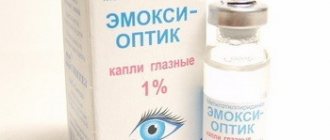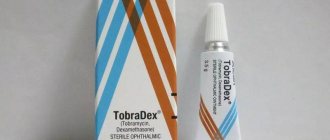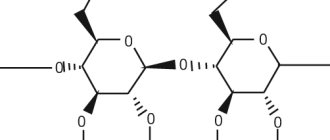Vitabact eye drops are a medicine that is used for preventive and therapeutic purposes of inflammatory diseases of the organ of vision of a bacterial, viral and fungal nature. The drug has a pronounced antiseptic and antimicrobial effect. It contains no preservatives, which makes it possible to prescribe drops for the treatment of very young patients.
Indications for use
Eye drops are prescribed in the presence of pathological conditions:
- conjunctivitis;
- damage by bacterial microflora of the anterior part of the eyes;
- keratitis;
- preventive measure against infection with viral conjunctivitis;
- blepharitis;
- infectious lesions due to obstruction of the lacrimal canal;
- dacryocystitis;
- prevention of complications after surgery;
- iritis;
- to prevent the development of complications due to cleaning the lacrimal canal;
- elimination of inflammation due to trachoma.
Prices in pharmacies
The cost indicated in the article is approximate and depends on the pharmacy chain and region of the country:
- Vitabact - 310-370 rubles, produced in France.
- Okomistin - 130-150 rubles, manufactured in Moscow.
Vitabact is the drug of choice for the treatment of infectious eye diseases in children under 3 years of age. For older children and adults, the use of Okomistin is more appropriate due to its wider spectrum of action and lower cost.
One of the most common eye diseases in children is conjunctivitis, more about it in the video:
Instructions for use
On average, Vitabact is applied 1 drop. The frequency of instillation per day is from 2 to 6 times, depending on the indications. To carry out instillation, children must adhere to certain steps:
- To open the drops, you need to twist the cap on the bottle until it stops.
- Before instillation, you must wash your hands with an antibacterial agent.
- Remove all crusts and pus from the child's eyelashes and conjunctiva using a cotton swab.
- The baby's head is placed in a backward position. When instilling, you need to look up.
- The upper eyelid is carefully pulled back and, without touching the mucous membranes, a drop of the product is applied.
- Repeat the procedure on the next eye, regardless of the lesion.
- After the procedure, it is necessary to close the bottle tightly to maintain the sterility of the solution.
Composition, release form
The bactericidal substance picloxidine dihydrochloride (500 mcg) is the active component of Vitabact ophthalmic drops. The additional ingredients are:
- emulsifier - polysorbate 80;
- natural monosaccharide – dextrose (anhydrous);
- purified water.
Vitabact eye drops for newborns, children and adults are a colorless liquid solution for topical use. Packaged in plastic transparent dropper bottles of 10 ml. Each cardboard package contains 1 tube of solution and detailed instructions for use.
special instructions
Before use, please read the special instructions for using the product:
- To maintain sterility, the bottle must not be touched to mucous or other contaminated surfaces;
- Before applying the product, the child needs to wash his hands with antibacterial soap;
- if there are suppurations or crusts on the eyelids, they must be removed;
- Eye cleansing is carried out with a cotton swab moistened with warm water, towards the nose.
To treat each pathology, a specific regimen and dosage of Vitabact is required.
Bacterial infections
If the organs of vision are damaged by bacterial microflora, it is necessary to take a course of Vitabact lasting 10 days. Apply 1 or 2 drops to each eye. The frequency of daily application is from 2 to 6 times a day. The drug is administered intraconjunctivally. More precise dosages are prescribed individually for the child by the pediatrician.
Dacryocystitis
For dacryocystitis, the course ranges from 10 days to 2 weeks. For newborns, other dosages of the drug may be selected.
After surgery
Before surgery, Vitabact is administered 1 drop several hours before surgery. During the rehabilitation period, the medicine is prescribed 1 drop into the organs of vision. Instillations are carried out 3 to 4 times a day.
Prevention of viral conjunctivitis
After contact with a patient with conjunctivitis, Vitabact can be instilled as a preventive measure. In this case, the child is prescribed 1 or 2 drops per day. The frequency of application is from 2 to 3 times. For prevention, the medicine is instilled for 3 days.
Analogs
- Tobrex. The active substance is tobramycin. Manufacturer: Alcon Laboratories (USA). The indications are the same as for Vitabact: eye infections, prevention of postoperative complications. For most eye infections, you can take Vitabact or Tobrex, which is better to use in each specific case, the doctor must decide. Contraindications: intolerance to components. Use with caution during pregnancy and breastfeeding (the benefit must outweigh the risk). Side effects: redness of the conjunctiva, swelling of the eyelids, itching in the eyes. The price of the drug is from 200 rubles.
- Phloxal. The active substance is ofloxacin. Manufacturer: Bausch & Lomb (USA). The remedy is indicated for conjunctivitis, corneal ulceration, dacryocystitis, barley, etc., and has no age restrictions. Contraindications: pregnancy, lactation, intolerance to components. Possible side effects are burning, itching. Price – from 190 rub.
- Vigamox. The active substance is moxifloxacin. Manufacturer: Alcon Laboratories (USA). The drug is indicated for bacterial conjunctivitis. Contraindications: under one year of age, individual intolerance, pregnancy, breastfeeding. Side effects: itching, eye irritation, dizziness. Price – from 180 rub.
- Conjunctine. The active substance is decamethoxin. Manufacturer: GNTsLS plant (Ukraine). The drug is indicated for conjunctivitis, chlamydia of the eye mucosa. Contraindications: pregnancy, breastfeeding, individual intolerance. Price – from 170 rub.
- Normax. The active substance is norfloxacin. Manufacturer – Ipka (India). Drops are indicated for ophthalmic infections (conjunctivitis). Contraindications: pregnancy, lactation, age 15 years. Possible side effects: dizziness, headache, allergies. Price – from 130 rub.
Other analogues: bactavit, azidrop, chloramphenicol, garazon, tsipromed.
Related articles:
- Vitrectomy: cost of surgery, reviews, indications
- Midrimax (eye drops): reviews, price in the pharmacy, instructions for use, analogues
- Eye drops Artelak Splash, Balance, Uno: reviews, cost, analogues
- Midriacil (eye drops): instructions for use, price, analogues, composition, reviews
Reviews from doctors
Olga Anatolyevna, ophthalmologist: I prescribe medication to prevent infection with conjunctivitis in children. In kindergartens and schools, no one is immune from this pathology, since there is a high density of children in these places. At the first suspicion of the development of viral conjunctivitis, a few drops of Vitabact will not only reduce the likelihood of infection, but also act as an additional prevention of bacterial damage to the organs of vision. I also prescribe the medication to infants up to one year old in the presence of dacryocystitis. However, treating this disease with Vitabact takes quite a long time.
Ivan Aleksandrovich, pediatrician: Vitabact is an effective salvation. The medicine can be prescribed even to the smallest children, which significantly expands the possibilities of drug treatment. Before possible surgical intervention, I prescribe the drug for 3 days to prevent complications due to surgery. I advise all mothers to give their child 1 drop of medication after visiting particularly crowded places. But you should not overuse the medicine, as it may lose its effectiveness.
Interaction with other drugs
When used together with antibiotics or antiviral agents, the effect of the drops is multiplied. When using various ophthalmic agents simultaneously, they should be used at intervals of 15-20 minutes. The effect of Vitabact is reduced when combined with glucocorticosteroids.
Shelf life and storage
After the date of manufacture, the medicine is suitable for use for 2 years. After the first opening, the shelf life is reduced to 30 days. After this period, the product should be disposed of. Do not allow children to use the product independently.
Vitabact eliminates not only the pathology itself, but also acts as a preventive measure against infection. The medicine has a minimum of side effects, which indicates its safe use by children. Before first use, it is advisable to check for allergies to the components of the medication.
Author's rating
Author of the article
Alexandrova O.M.
Articles written
2031
about the author
Was the article helpful?
Rate the material on a five-point scale!
( 3 ratings, average: 2.67 out of 5)
If you have any questions or want to share your opinion or experience, write a comment below.
pharmachologic effect
The active ingredient picloxidine gives the drug a powerful antiseptic and disinfectant effect. Due to this, the antimicrobial effect of Vitabact eye drops is manifested. They are active against most gram-positive and gram-negative bacteria:
- streptococci (lat. Streptococcus);
- staphylococci (lat. Staphylococcaceae);
- shigella (lat. Shigella);
- chlamydia (lat. Chlamydia), etc.
Some pathogenic viruses and fungi are sensitive to the medication.
The antiseptic destroys the membrane of bacterial cells, leading to their death. Systemic absorption is extremely negligible when applied topically.
Possible adverse reactions
Perhaps the main advantage of this medicine is that it practically does not cause adverse reactions. As noted above, in rare cases, the patient may experience an allergy, manifested in the form of red eyes and itching. This reaction is associated with individual intolerance.
There have been no cases of overdose with Vitabact. However, during use, it is better to follow the rules prescribed by your doctor.
How to understand an ophthalmological extract - deciphering visometry indicators.
Instillation technique
When is it justified to prescribe Visomitin eye drops, read the article.
Precautionary measures
Eye drops do not stain the surface of contact lenses. It is worth considering that wearing lenses for infectious eye diseases (including conjunctivitis and blepharitis) is contraindicated.
The antibiotic is not intended for subconjunctival injections into the anterior part of the visual organ.
During treatment with an ophthalmic drug, visual acuity may temporarily decrease. If such a symptom is detected, you should stop driving and avoid work that requires increased concentration.
Medicinal properties
Vitabact is a local antiseptic.
Upon contact with the mucous membrane of the eye, the antimicrobial properties of the drug are observed. The main active ingredient of Vitabact is a derivative of biguanides.
The antibacterial agent effectively treats infections localized in the anterior part of the organ of vision. Picloxidine is active against chlamydia, cocci, E. coli, some types of fungi and viruses, as well as Shigella.
Thanks to the local use of Vitabact, partial penetration of the main component into the systemic circulation is observed due to the low absorption of picloxidine by the ocular mucosa.
Contraindications
The only serious contraindication is individual intolerance to the components. That is why before using the drug you need to consult a doctor and study the composition.
The main symptom of an allergic reaction to Vitabact is redness of the eyes and itching. In this case, you need to minimize contact with the components of the drug.
Another important nuance is the use of drops during pregnancy. The manufacturer does not prescribe clear contraindications, but the effects of the components on the mother and fetus have not been fully studied. Since the product can harm the baby’s well-being, it is better to refrain from using Vitabakt.
Before using Vitabact in childhood and in newborns, you should always consult an ophthalmologist so as not to harm the formation of a healthy visual system.
Does your child have difficulty distinguishing shades or colors? – Find out how to identify color blindness.
For dacryocystitis, an important part of treatment is massage.
Protection against seasonal allergic conjunctivitis - Visallergol eye drops.









